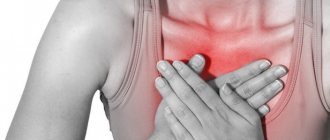Pain under the collarbone makes you think even if it is of a traumatic nature. Although in the vast majority of cases, a thorough diagnosis reveals that there is no traumatic tissue damage. In childhood, pain in the front under the collarbone can be associated with both a traumatic fracture and a very dangerous disease, leukemia. In the first case, the integrity of the hollow bone, which has not yet fully formed in the baby, is violated. In the second case, internal pressure is exerted on the collarbone due to enlargement and inflammation of the thoracic lymph nodes (mediastinum). They put pressure on the collarbone on one or both sides.
Therefore, parents whose child aged 3–6 years complains of pain in the collarbone area should immediately contact a pediatrician and have blood tests done. A consultation with a traumatologist and an x-ray are also indicated. It is very difficult to notice the moment a baby gets injured. But even an unsuccessful fall on the shoulder or outstretched arm can lead to the acromial or lateral end of the clavicle coming out of the articular cavity.
In an adult, pain under the collarbone in front is almost always associated with arthrosis of the sternoclavicular and clavicular-scapular joints. In approximately half of the cases the pain is false. This is associated with radicular syndrome against the background of cervical osteochondrosis. The patient feels pain radiating from the neck and collar area under the collarbone. For diagnosis, it is enough to collect a thorough history of the disease and take an x-ray of the cervical and cervicothoracic spine.
If you have pain under the collarbone, we recommend that you consult an experienced doctor as soon as possible. Such diseases are treated by an orthopedist or a neurologist. You can get a free consultation with these specialists in our manual therapy clinic. Call the administrator and sign up for a free initial appointment.
Causes of pain under the collarbone
All potential causes of pain under the collarbone can be divided into several groups: inflammation, deformation, trauma, tumors, irradiation. Let's look at them all in order in more detail.
Let's start with the “classics of the genre” - traumatic influence. These can be dislocations, blows, bruises, hematomas in the periosteum, cracks and fractures of bone tissue. Occurs when falling, awkward movements, or during active game sports.
The second most common cause of pain under the collarbone is deformation of cartilage and bone tissue. There are several important aspects to know here:
- the collarbone has two joints (the first attaches it to the sternum, the second to the scapula);
- both bone joints have some mobility;
- with insufficient work and physical activity of the pectoral muscles, the process of degeneration and thinning of the cartilage tissue covering the distal heads of the clavicle begins;
- after the destruction of cartilage tissue, deformation of bone tissue begins;
- cracks appear on it, which are filled with deposits of calcium salts in the form of rough growths and thorns.
When making any movements in the shoulder joint when the bone tissue of the clavicle is deformed, sharp pain occurs due to the fact that soft tissues are injured. The sternoclavicular joint is most often affected. The pain is localized at the point where the collarbone attaches to the sternum. the acromial joint with the scapula gives another localization of pain - in the area of the shoulder joint and under the armpit.
Inflammatory processes in the area of the attachment points of the collarbone can be caused by a number of specific factors:
- consequences of sprain of the ligamentous and tendon apparatus, which caused internal hematomas;
- infectious tissue damage (with the generalized spread of pathogens from foci of chronic or acute inflammation through the blood or lymphatic fluid);
- an autoimmune process such as rheumatism and destruction of cartilage tissue due to improper functioning of the immune system;
- damage to the outer skin;
- development of arthritis or exacerbation of chronic arthrosis;
- inflammation of the synovial cartilaginous membrane;
- myositis, tendonitis and other diseases.
The tumor nature of the development of pain in the clavicle area is common mainly in childhood. Metastasis to the lymph nodes often leads to a sharp increase in their size. They begin to put pressure on the bone structure of the collarbones. This causes a dull, stabbing pain.
Irradiation of pain under the collarbone can occur with damage to the cervical and cervicothoracic spine. Often a similar symptom occurs with cervical osteochondrosis, instability of the position of the vertebrae, their displacement, the development of uncovertebral arthrosis, etc. When the root nerves are damaged, a disruption of the innervation of the soft tissues of the neck and clavicle area occurs. In this case, accompanying symptoms may be present, such as a sore throat, a feeling of increased volume of the tongue, and difficulty swallowing.
There are other symptoms of pain in the collarbone area. However, the factors listed are the most common. They should be excluded first during differential diagnosis.
Diagnostics
The diagnosis is established by an orthopedic traumatologist. For neurological causes of pain, diagnosis is carried out by a neurologist; for somatic pathology, the examination is carried out by doctors of relevant specialties. The following diagnostic procedures are prescribed:
- X-ray of the clavicle.
Basic research for pathology of bones and joints. The images visualize fracture lines, displacement of articular surfaces during dislocations, disturbances in the structure and shape of bones due to tumors, osteomyelitis, osteitis deformans, deformations, changes in the configuration of joints due to arthrosis and psoriatic arthritis. - Ultrasound of soft tissues.
It is performed to assess the condition of the soft tissue structures surrounding the collarbone. Reveals signs of inflammation and degeneration, foci of calcification. If blood vessels are compressed, special ultrasound examinations may be performed. - CT and MRI of the clavicle.
They are carried out to detail the nature, location and extent of pathological changes, clarify data obtained during other diagnostic procedures, and select conservative or surgical treatment tactics. - Neurological EFI.
If a neurological etiology of the pain syndrome is suspected, patients are shown electromyography or electroneurography. - Lab tests
. General and biochemical blood tests are prescribed to assess the general condition, identify signs of anemia, and the inflammatory process.
The list of studies for damage to internal organs is determined individually. For pathological processes in the chest area, an ECG, radiography of the chest cavity, and CT of the chest organs are prescribed. For diseases of the hepatobiliary zone, ultrasound, MRI and CT scans of the liver and gallbladder are performed, as well as tests to determine the level of bilirubin. For symptoms of other diseases of the abdominal cavity, an ultrasound of the abdominal organs is performed. If there are signs of intra-abdominal bleeding, diagnostic laparoscopy is performed.
Radiography. Clavicle fracture
What is the difference between pain under the left and right collarbone?
It is important to understand that pain under the left collarbone in some cases can be associated with myocardial diseases. These are angina pectoris, coronary heart disease, atherosclerotic lesions of the coronary blood vessels, valve disease, myocardial infarction, etc. Also, false pain under the left clavicle can occur with the cardiac type of vegetative-vascular dystonia. therefore, if such a symptom appears, you should immediately contact your doctor and ask for a referral for an ECG.
This examination will exclude organic, vascular and neurological damage to the heart muscle. Next, you should consult a neurologist regarding the diagnosis of vegetative-vascular dystonia. And only after this should you look for pathology of the musculoskeletal system (arthrosis, arthritis, deformity, traumatic damage to the acromial or sternal joint).
The first difference between pain under the right collarbone is the exclusion of vascular and cardiac pathology. When such a symptom appears, you can immediately begin diagnosing diseases of the bone and cartilage, articular and spinal structures. It is important to exclude the following pathologies step by step:
- arthritis of the sternoclavicular or acromioscapular joint (manifested by severe pain on palpation, inflammation and swelling of the joint capsule);
- arthrosis of similar joints (manifested by a characteristic crunch when moving, pain on palpation, limited mobility in the shoulder joint);
- habitual dislocation of the collarbone (often occurs in people who are accustomed to actively gesturing with their hands during an emotional conversation; the displacement of the collarbone is visible to the naked eye in the form of a deformation of the chest in this area);
- inflammation of the lymph nodes;
- rheumatism, inflammation of joints and bone tissue;
- bone tuberculosis and other dangerous infections.
Only an experienced doctor can detect the exact cause of pain under the collarbone. Already during the collection of anamnesis and the initial examination, he will be able to make a preliminary diagnosis and prescribe additional examinations. Do not waste time, do not engage in self-diagnosis and treatment. Sign up for a free initial consultation with our orthopedist.
Treatment
Help before diagnosis
For injuries to the collarbone, hang the arm in a bandage, apply cold, and give an analgesic. For non-traumatic pathologies without signs of severe inflammation, the arm is provided with rest, and painkillers and warming agents are applied to the painful area. Progression of pain, increased body temperature, the appearance of significant swelling and hyperemia is a reason to immediately contact a specialist.
Conservative therapy
In case of clavicle fractures, reposition is carried out; in children, the limb is fixed with Delbe rings, in adults - with a Deso bandage. Patients with bruises and non-traumatic diseases are advised to reduce the load on the limb. The protective regimen option is chosen taking into account the type of pathology; complete rest is recommended only during periods of exacerbations; the rest of the time it is advised to maintain sufficient physical activity to avoid atrophy and the development of contractures.
In the treatment of diseases of the collarbone, non-drug methods are widely used - massage, physical therapy. Shock wave therapy is considered a promising method. The following types of physiotherapy are used:
- medicinal electrophoresis;
- UHF;
- magnetic therapy;
- laser therapy;
- ultrasound;
- electrical stimulation.
The drug therapy plan is drawn up taking into account the characteristics of the disease. Infectious processes require antibiotic therapy. For chronic inflammatory and degenerative diseases, NSAIDs of general and local action are prescribed, and blockades with corticosteroid drugs are performed.
Surgery
Most often, operations on the collarbone are performed during the treatment of injuries and their consequences. Depending on the type of damage, the following is carried out:
- Osteosynthesis of the clavicle.
It is indicated as an emergency in case of damage or threat of damage to the neurovascular bundle by a bone fragment. It is performed as planned when reposition is ineffective and it is impossible to conservatively hold the fragments in the correct position. - Open reduction of dislocation.
Clavicle dislocations are easily reduced, but are poorly maintained and therefore require surgical treatment. Taking into account the location of the dislocation, plastic surgery of the acromioclavicular or sternoclavicular joint is performed. - Plastic surgery for pseudoarthrosis of the clavicle.
Recommended in the absence of fusion of fragments. The fragments are fixed using bone autograft.
If compression of blood vessels and nerves is caused by a congenital anomaly, resection of the cervical rib may be required. For other neurological causes of pain, neurosurgical interventions are performed in some cases. The tumors are excised or bone resection is performed.
Aching and nagging pain under the collarbone when inhaling
Quite often, pain under the collarbone appears when inhaling through movement of the chest. A characteristic clinical sign is that when inhaling using the movement of the diaphragm (stomach), there is no pain under the collarbone.
In order to find out the cause of such aching pain under the collarbone, it is necessary to exclude pathologies of the intercostal muscles, neuralgia, diseases of the lung tissue and bronchial tree. Usually, it is enough to collect the patient’s history and complaints. With diseases of the respiratory system, shortness of breath, cough, and general weakness will be present. And with pathologies of the intercostal muscles and neuralgia, it is certainly possible to detect pain on palpation of the chest.
If the nagging pain under the collarbone is provoked by cervical osteochondrosis with radicular syndrome, then the following accompanying signs can be detected:
- pain on palpation of the neck and collar area;
- muscle tension in the collar area and shoulders;
- difficulty moving the head;
- pain spreads along the entire nerve fiber, i.e. may be observed in the forearm, shoulder, wrist, etc.
For diagnosis, it is necessary to take an x-ray, ECG, MRI or CT examination. The primary diagnosis can be made by an orthopedist, neurologist or chiropractor. You can get their free consultation at any time that is convenient for you in our manual therapy clinic.
Prevention
Pain in the collarbone and neck area can occur for various reasons, and no one is immune from this unpleasant symptom. To avoid having to start long-term treatment again, for prevention you should get into the habit of:
- Physical exercises and warm-up: will prevent osteochondrosis if a person is in the same position for a long time, and will also prevent myalgia from developing.
- Timely treatment of infectious and viral diseases: this will prevent pain in the collarbone and neck due to myalgia that accompanies these diseases.
- Timely consultation with a doctor in case of injuries will help avoid the negative consequences of fractures. Also, in order to avoid pain in the collarbone and neck area, it is recommended to prevent hypothermia of the body, when it becomes especially vulnerable to infections and viruses, against which more serious pathological conditions can arise.
How to treat shoulder and chest pain under the collarbone?
Before treating shoulder pain under the collarbone, it is necessary to conduct a differential diagnosis and identify the potential disease that causes it. Already during the initial examination, the doctor will be able to make a preliminary diagnosis. So, if pain appears under the collarbone when you press on certain points of its attachment to the sternum or scapula, then there is a high probability of violating the integrity of the joint capsule. In this case, pain can be relieved if their integrity is restored. A chiropractor or osteopath can help in this matter. Then a specialist in kinesiotherapy and therapeutic exercises will strengthen the muscle frame and prevent relapse of the disease.
If chest pain under the collarbone is caused by cervical osteochondrosis and its complications in the form of protrusion and hernia, then traction traction is sufficient for the initial relief of the attack. This procedure eliminates compression of the radicular nerves. The patient experiences a significant improvement in his condition. However, this is not a complete treatment. In the future, it is necessary to complete the entire course of therapy, developed individually by a chiropractor or neurologist.
This will allow you to completely heal the cervical spine, remove pain under the collarbone and regain freedom of movement.
It is not recommended to treat such conditions at home without medical help. First of all, you will not be able to independently find out the cause of the pain under the collarbone. Accordingly, the treatment may be completely wrong and only cause harm to your health. Don't risk it. Contact experienced specialists for an appointment.
RECOVERY AND PREVENTION OF RECURRENCES
The treatment of any arthritis, including pathology of the joints “connected” to the clavicle bone, is based on three directions:
- Medication. Analgesics and anti-inflammatory (non-steroidal) medications will help relieve pain and help you get a good night's sleep.
- Severe pain in the anterior part of the clavicular bone often occurs at night; against the background of fatigue and lack of sleep, the patient may develop psychological instability. To normalize his condition, antidepressants and sedatives are prescribed.
- A set of exercises is recommended both during the treatment of arthritis and during remission. Exercise therapy strengthens the affected area, triggers natural regenerative processes, and restores the mobility of the clavicular bone.
- Advanced clinics practice manual therapy, treatment with warm compresses and exposure to bioactive points for arthritis of the clavicular bone.
- Particularly severe cases require radical treatment with arthroplasty or surgical cleansing of the inflamed areas.
The prognosis for active treatment of arthritis in the case of damage to the clavicular bone is good. To prevent relapse, experienced rheumatologists recommend cryotherapy, swimming and self-care. If arthritis is triggered by frequent microtraumas at work, it is advisable to change jobs.









